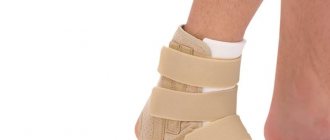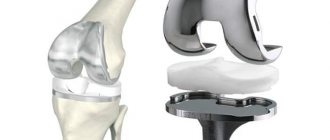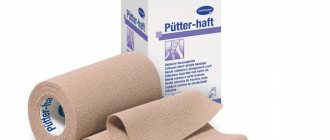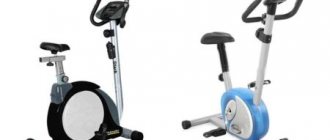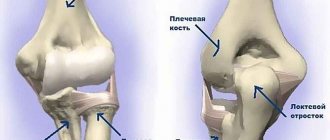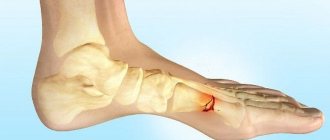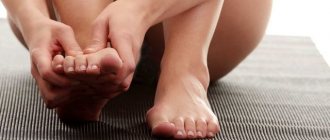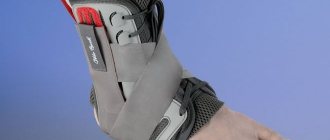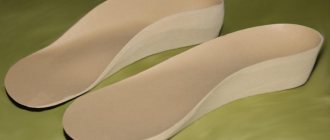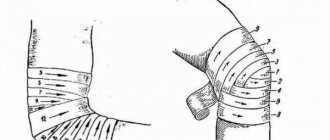02/27/2020 The daily loads experienced by our ankle joint are quite large. When walking, this joint redistributes the load from the heel to the foot (its front part). It gives confidence and smoothness to a person’s gait and is often subject to wear and tear and injury. The injured joint must be fixed in its normal position, which can be effectively done through the use of an orthosis (bandage).
What is the need for using an orthosis?
An ankle orthosis is a device that allows you to fix the ankle. This device can be called extremely high-quality in use, and its appearance is like a long sock. Ankle orthoses are manufactured using materials with good density and elasticity properties, with plastic or metal inserts. To fix them, various fasteners are used, through which you can adjust the size and level of fixation of the device. One of the benefits of a brace is that it allows the leg to move. In addition, this device is characterized by high fixation ability.
The purpose of ankle orthoses is to:
- Immobilization of the ankle joint for various diseases associated with the apparatus responsible for musculoskeletal function.
- Carrying out preventive measures for ankle injuries in people involved in sports, tourism, as well as leading an active lifestyle and often exposed to various troubles, and so on.
- Prevention of inflammation and injury in patients suffering from obesity.
- Prevention of bone tissue deformation in people prone to such pathological changes.
- Prevention of inflammation and injury in people who experience high stress on their limbs due to other factors, such as professional activities.
- Relieving pain.
- Acceleration of recovery terms. According to the results of practical studies, thanks to the use of an orthosis, damaged tissues are restored relatively quickly.
Ankle brace: what is it, types of orthoses
An ankle brace is a device worn on this part of the leg, made of different materials to ensure reliable fixation of the ligamentous apparatus of the joint and the bones that form this joint. Previously, plaster casts or elastic bandages were used for these purposes. However, now progress in the field of orthopedic products allows the use of more convenient and functional retainer models.
An ankle brace, the benefits of which are obvious in the treatment of a wide variety of injuries and diseases, can be manufactured in different models:
- hard
– are made using metal or plastic ribs, provide stable fixation, can be used even for fractures and are not inferior to plaster casts in terms of mobilization density;
- splint designs
– they do not have hinges, and this helps the doctor to easily observe how the bones grow together; if necessary, as the damaged tissues heal, the degree of fixation can be adjusted;
- semi-rigid
– the level of fixation in them allows you to maintain slight mobility of the joint, limits its movement to the required extent, eliminates the fear of stepping on the sore leg;
- soft
– worn to prevent sprains (often used by athletes) or during the rehabilitation period after ankle injuries;
- medicinal
– drugs with different properties (anti-inflammatory, warming, etc.) have been introduced into the material of the bandages.
Depending on the purpose of use, ankle braces are divided into the following types:
- corrective
– eliminate joint deformation;
- fixing
– provide immobilization of joint tissues and bones;
- compression
– worn both to fix joint structures and to accelerate the healing of warming tissues;
- unloading
– reduce the load on the ankle;
- dynamic
– used to maintain normal functioning of the joint.
There are also special ankle braces used for foot drop. It can be:
- bandages with hinges
– do not limit mobility, but protect joint structures;
- hingeless clamps
– used for severe pathologies.
Before purchasing an ankle orthosis, it is better to consult with a specialist. A doctor or an experienced consultant will recommend the type of brace required in a given clinical case, and will take into account all the features of the existing injury, disease, load on the leg or lifestyle.
Indications
Orthoses are prescribed by medical specialists in a number of specific cases, namely:
- some diseases of an inflammatory and degenerative nature (primarily arthritis and arthrosis);
- fractures, subluxations and dislocations;
- unstable position of the joint;
- congenital anomalies, rickets in a child and other childhood pathologies;
- the need for injury prevention in patients suffering from obesity, as well as in athletes;
- and etc.
How to wear a finger brace
Only a doctor should put on and remove a finger brace. Therefore, after purchasing the product, you should immediately go to a traumatologist or orthopedist. The specialist will put on the orthosis, adjust the level of fixation, and tell you when you can remove the product - the doctor will also do this.
It is prohibited to remove the orthosis before the date approved by the doctor. If a fastening defect is discovered on it or any discomfort appears (numbness of the finger, tingling), you should consult a doctor, but under no circumstances remove the product.
Contraindications
You cannot wear a finger brace if:
- diabetes mellitus;
- gout;
- the presence of wounds on the skin of the finger that are slowly healing or suppurating;
- cracks in the skin or sutures after surgery;
- poor blood circulation in the extremities.
Before purchasing a finger orthosis, be sure to consult with your doctor or orthopedist.
How to care
You should try not to wet the orthosis with water or other liquids. If this happens, it should be wiped with a dry or damp cloth. The use of any cleaning agents or detergents is prohibited.
Classification
Next, we will analyze the main types of orthoses, divided according to the criterion of rigidity:
- Products of a soft look (with a light and medium level of fixation). Soft materials (fabric, etc.) are used to make soft orthoses, so they are more similar to socks than others. Their use is most often due to the need for preventive work and treatment of ankle injuries. This type of orthosis is the easiest to use and care for (characterized by the ability to easily put on, wash and wear in shoes).
- Semi-rigid products (with strong fixation). Plastic or metal inserts increase the level of fixation of these products, which can easily replace plaster. Semi-rigid orthoses most often include lacing or belts.
- Products of a rigid type (with 100% fixation). These orthopedic devices have a maximum level of fixation, and their equipment includes rigid inserts or splints. In the most common cases, they are used for joint diseases or fractures.
Content:
- Ankle brace: what is it, types of orthoses
- What materials are used to make ankle braces?
- How to choose the right ankle brace?
- Short description
Ankle injuries occur very often and not only among athletes. These may be dislocations, subluxations, sprains, cracks or fractures. In all these cases, to ensure adequate treatment, a mobilizing bandage called by different terms is used: orthosis, bandage, fixator. A bandage for the ankle joint after a fracture or other injury can be purchased in an online store, pharmacy or specialized departments of orthopedic products. The range of these devices is extremely wide. You will learn how to choose an ankle brace and not make a mistake by reading this publication.
Choosing the right size
Based on the diagnosis and individual characteristics of the patient (weight parameters, age characteristics), the medical specialist prescribes an orthosis. In this case, the patient should pay attention not only to the recommendations of the treating doctor. He should know that the size of the orthosis will depend on the characteristics of the foot, ankle, ankle, lower leg, and ankle.
It should also be taken into account that the effectiveness of treatment is directly affected by the optimal selection of the size of the orthosis. If the product is of the wrong size, it will not have the desired effect, but may only aggravate the problem.
Our salon's highly qualified specialists will be happy to provide you with practical recommendations on determining the size of the orthosis.
Basic rules for using orthoses
Do you want to get the greatest effect from wearing an ortho-device? In this case, you must adhere to the manufacturer’s recommendations and follow the advice of your doctor. When wearing the medical device in question, it is important to consider a number of the following points:
- Correct donning. The key to effective use of the chosen orthosis is correct fixation. The patient should feel a slight tension. It is recommended to seek the help of a specialist when putting on a bandage or corset for the first time. A competent specialist will tell you and show you in what order you need to fasten the clips, belts, etc. Only by knowing the specifics of setting up an orthopedic device can you learn how to operate it yourself.
- Duration of wearing. How long you need to wear a medical device can only be determined by a qualified doctor. To calculate the duration of operation, the diagnosis of the disease and the degree of its development are taken as the basis. Independent conclusions are fraught with negative consequences.
- Regular care. Like all textile products, the orthosis tends to get dirty over time. Not all models are machine washable. Manual care is necessary for products that are equipped with plates and stiffeners. The use of aggressive powders is prohibited. Manufacturers recommend washing such items in 40 degree water with mild soap. To properly dry the product, it is enough to straighten it on a horizontal surface.
If you have difficulties choosing an orthopedic device, if you want to learn as much as possible about the operation of this device, contact your doctor.
Ankle structure
The ankle joint is a movable block-like joint of the bones of the foot and lower leg. This joint includes the tibia, talus and fibula.
The ankle is mobile:
- Along the frontal axis (the ability to bend and straighten the foot);
- Along the sagittal axis (slight abduction and adduction).
The list of the most common ankle problems includes:
- Inflammatory processes (arthritis, osteoarthritis);
- Injuries (bruises, dislocations and subluxations, bone fractures and sprains, wounds of various origins);
- Diseases and congenital pathologies of the joint (flat feet, hallux valgus, chronic instability, foot drop, etc.);
- Paresis and paralysis resulting from previous injuries and surgical interventions;
- Children's pathologies (rickets, ankle dysplasia).
The ankle joint experiences intense stress as the entire mass of the human body presses from above. This joint is at risk if a person leads a sedentary lifestyle or is overweight. Additionally, women who wear high heels and athletes are among the people most at risk of ankle injury.
Injuries and pathologies in this area knock a person out of his usual rhythm for a long time, preventing him from moving normally.
If not properly cared for and treated, they can lead to bone misalignment, lameness, and chronic ankle problems. Therefore, it is critically important to immediately seek qualified assistance if any damage occurs.
Choosing the right bandage
- As we said earlier, an experienced specialist from the Orthopedic Center will help you choose the right bandage based on its functionality;
- The first thing you need to do when purchasing is to correctly determine the size of the ankle brace;
- The sizing chart for each company is individual, so when purchasing, be guided by the grid that is indicated on the product itself;
- Determine your shoe size (this can be done by the insole of the shoes you most often wear);
- It is necessary to measure the girth of the ankle (i.e. its circumference). Measurements should be taken at the narrowest part;
- Measure the circumference of your shin - the measurement takes place between the knee joint and ankle;
- The process of measuring the circumference of the ankle through the heel - place and press the heel firmly to the floor, use a centimeter tape to measure the circumference of the ankle at an angle, starting from the heel and ending below the bones located above the ankle;
- If your measurements are somewhere between two bandage sizes, then feel free to purchase the smaller of the two. If the retainer is too large, it will not be able to perform its functions efficiently. But too small a size is also fraught with consequences in the form of impaired blood supply;
- If you follow these rules when choosing an ankle brace, your purchase will be successful and useful. The model you purchase can become a faithful assistant both for fractures and bruises, and for the prevention of various injuries.
The main thing is to remember:
- The bandage should be chosen based on the functions it must perform;
- To ensure that the brace is selected correctly, pay attention to 4 things: shoe size, ankle circumference size, calf circumference size and ankle circumference size.
- If you have an average foot size (for example, 38.5), then always choose the smallest side.
What materials are bandage structures made from?
The material for the bandage is selected based on its model and purpose. For example, structures whose purpose is to retain heat and eliminate pain and swelling are created from neoprene.
For allergy sufferers, the best choice is the model with the highest cotton content.
Silicone inserts are used as part of the bandage for higher fixation and compression, which are necessary when there is a heavy load on the leg.
Elastic models that have additional straps or Velcro are popular, creating the greatest fixation of the bandage.
When purchasing a bandage structure, it is very important to choose a model made from quality materials. Our experienced consultants will be happy to help you with your purchase and tell you in detail about each model you are interested in.
How to wear a cervical brace
The cervical brace is placed on the bare neck and tightened so that blood circulates freely in the cervical region. Wear it only during the day during sedentary work or physical activity. The orthosis should be removed at night before going to bed.
This product can only be worn as prescribed by a doctor.
In the first few days, the orthosis should be worn for no more than 15 minutes. The neck needs to get used to such a collar. This will help eliminate discomfort. Every day the wearing time must be increased.
The maximum period during which a neck brace can be worn is 7 days. But still, the doctor sets the period, and in some cases it can be more than a week.
If during use of the product you experience pain or poor health, which may be accompanied by nausea and vomiting, you should immediately consult your doctor.
Contraindications
It is prohibited to wear a neck brace when:
- skin diseases;
- open wounds, fresh scratches and abrasions;
- heart attack;
- brain damage, for example after a stroke;
- impaired blood flow in the neck;
- neoplasms in places where the orthosis adheres to the skin.
In any case, before putting on a neck brace, you should consult your doctor.
